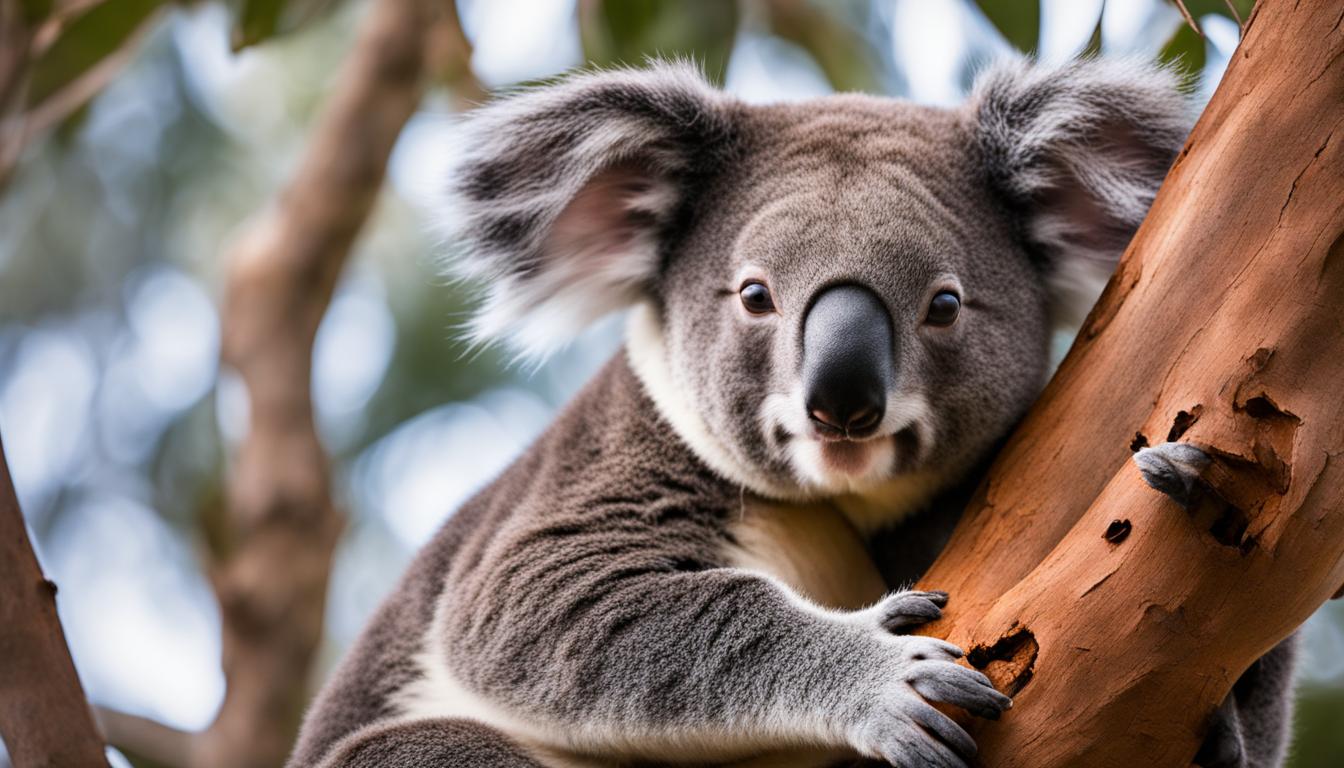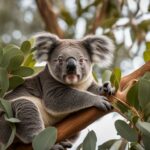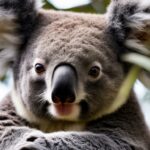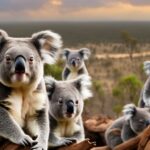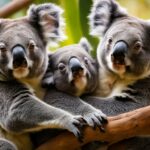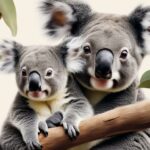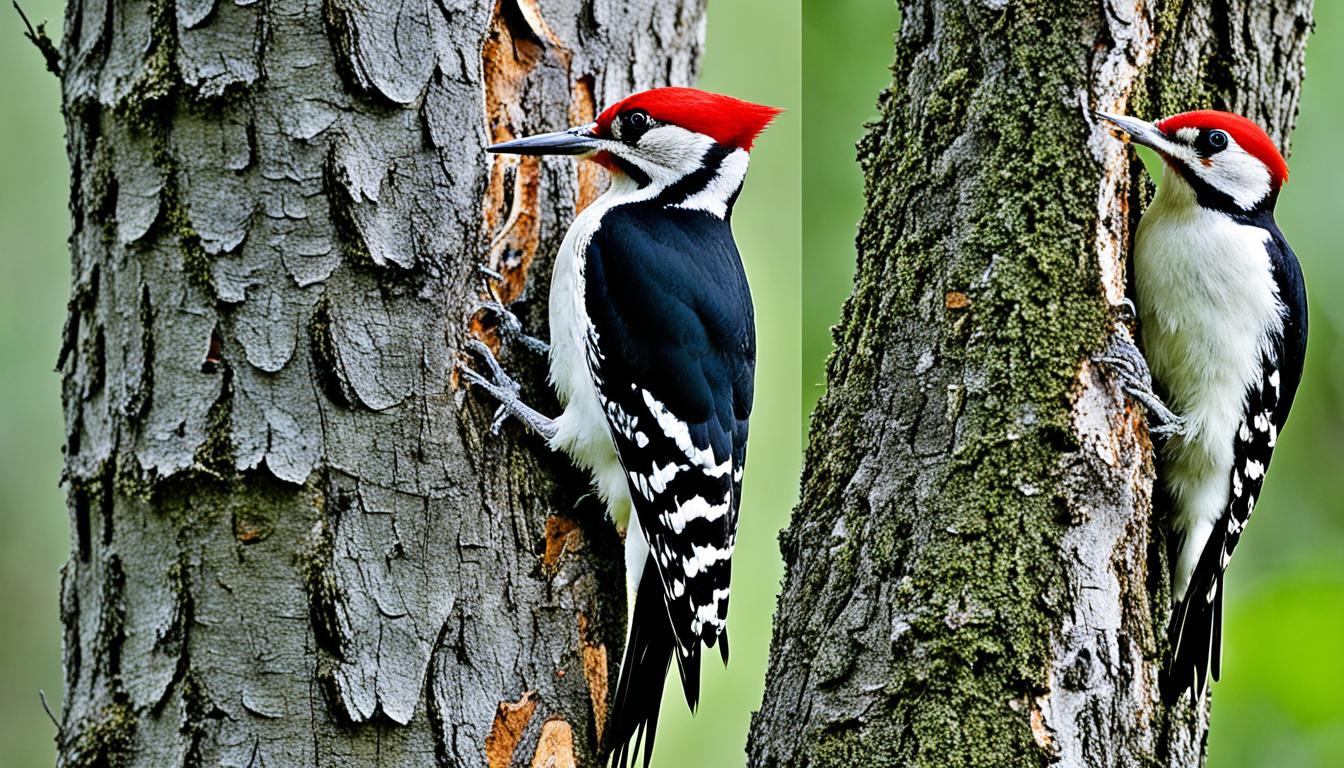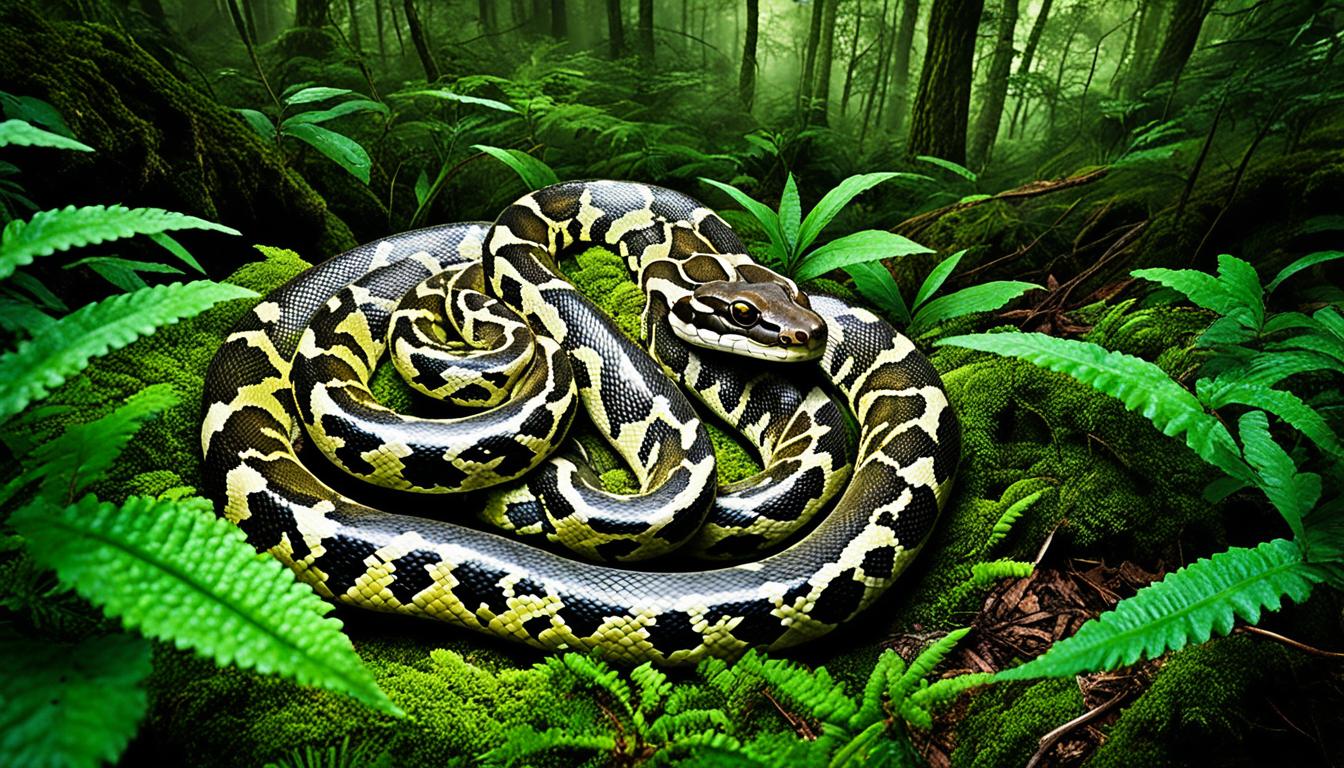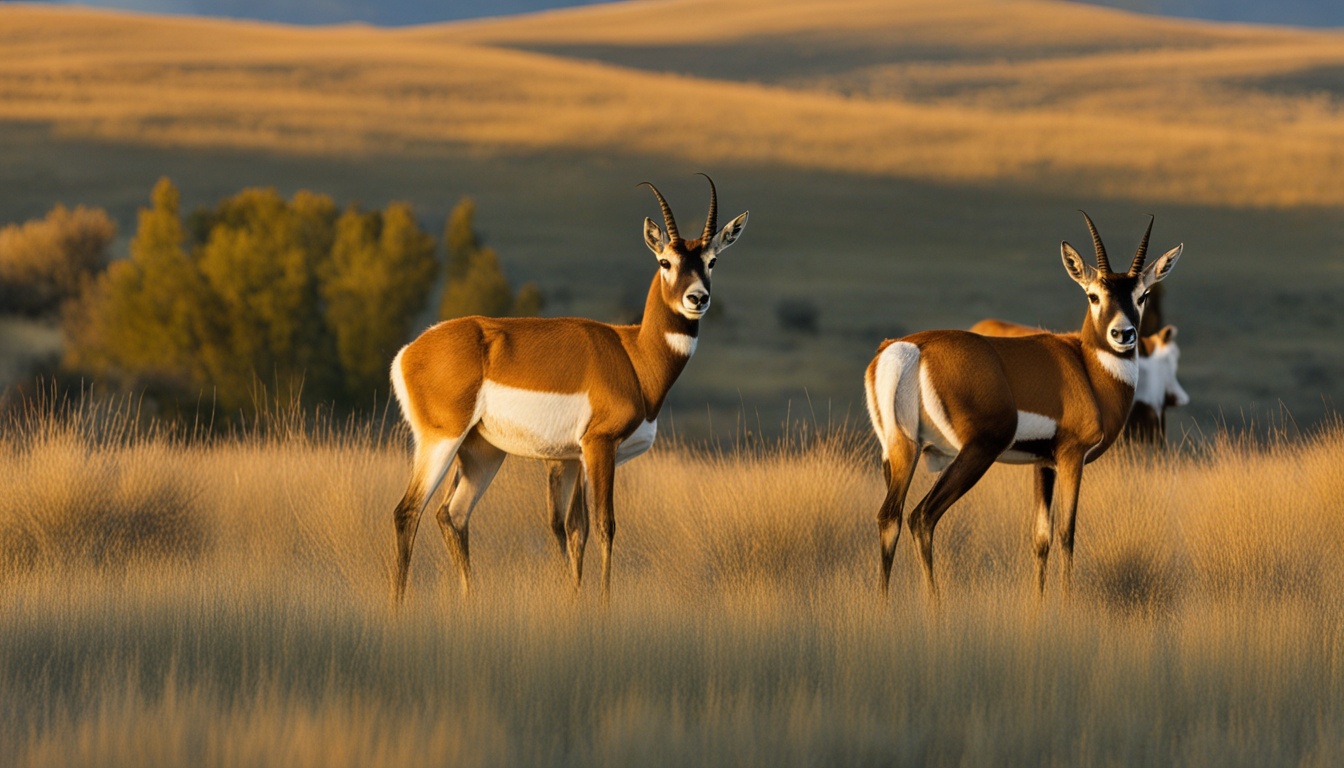Are you curious about how koalas thrive in their tree-dwelling habitat? Let’s explore the fascinating adaptations that make them masters of the treetops.
Koalas have evolved unique characteristics to suit their arboreal lifestyle. Their long, muscular limbs and sharp claws provide them with exceptional grip and agility, allowing them to navigate tree trunks with ease. Their fur, thicker on their rump, serves as a cushion when perching on branches, ensuring their comfort.
Their diet consists primarily of eucalyptus leaves, providing them not only with nutrition but also hydration. These leafy treats are essential to their survival, as they receive most of their water intake from the moisture within the leaves.
Despite their adorable appearance, koalas have a relatively low-energy lifestyle. They spend a significant amount of time sleeping, around 18 to 20 hours a day, conserving energy due to their nutrient-poor diet.
Stay tuned to discover more about the physical features, behavior, and conservation efforts surrounding these incredible tree-dwelling marsupials.
Physical Features and Classification of Koalas
Koalas, with their unique physical features and classification as marsupials, are fascinating creatures. Their lean bodies, long limbs, and large, sharp claws make them well-adapted for climbing and living in trees. Unlike most marsupials, koalas have a downward-facing pouch that opens toward their hind legs, allowing easy access for the joey. The scientific name for koalas is Phascolarctos cinereus, and their fur is predominantly gray-brown, with white fur on their chest, ears, arms, and bottom.
These physical features help koalas thrive in their tree-dwelling lifestyle. Their muscular limbs and sharp claws enable them to grip tree trunks securely, while their gray-brown fur provides excellent camouflage in their forest habitat. The white fur on their chest, ears, arms, and bottom helps them blend in with the tree branches and leaves. These adaptations are crucial for their survival in the wild and allow them to navigate their arboreal environment with ease.
As marsupials, koalas are part of the Phascolarctidae family, which includes other unique Australian marsupials like wombats. They share common characteristics with other marsupials, such as giving birth to relatively undeveloped young, which then continue to grow and develop inside the mother’s pouch. The classification of koalas as marsupials sets them apart from other mammals and reveals their evolutionary lineage and biological connections within the animal kingdom.
Koala Physical Features and Classification:
| Physical Features | Classification |
|---|---|
| Lean body with long limbs | Marsupial (Phascolarctidae family) |
| Large, sharp claws | Scientific name: Phascolarctos cinereus |
| Gray-brown fur with white fur on chest, ears, arms, and bottom | |
| Downward-facing pouch, opening toward hind legs |
Understanding the physical features and classification of koalas provides valuable insights into their unique adaptations and evolutionary history. These characteristics contribute to their ability to thrive in trees and survive in their native Australian habitat.
Koala Habitat and Distribution
Koalas, native to Australia, have a unique habitat and distribution pattern. They are predominantly found in the eastern and southern regions of the country. Koalas thrive in tall eucalypt forests, low woodlands, and coastal areas. Interestingly, they have also adapted to urban environments, making appearances in residential areas.
Queensland, New South Wales, Victoria, and a small area in South Australia are the primary regions where koalas are distributed. However, these regions have experienced significant habitat loss and fragmentation due to land clearing and development activities. This poses a grave threat to the survival of these adorable marsupials.
To protect the koala population and their habitat, conservation efforts are essential. Creating reserves and protected areas can provide safe havens for koalas to thrive. Additionally, raising awareness about the importance of koalas and their habitat is crucial to garner public support for conservation initiatives.
Koala Habitat and Distribution
| Region | Habitat |
|---|---|
| Queensland | Tall eucalypt forests, coastal areas |
| New South Wales | Tall eucalypt forests, low woodlands |
| Victoria | Tall eucalypt forests, coastal areas |
| South Australia | Small area with eucalypt forests |
Protecting and preserving the precious habitat of koalas is crucial for their survival. By conserving their habitat and taking measures to minimize human impact, we can ensure that future generations can continue to marvel at the beauty of these unique creatures.
Koala Behavior and Social Structure
Koalas exhibit unique behavior and have a well-defined social structure that contributes to their survival in the wild. Understanding their behavior and social interactions is essential for their conservation and protection.
Behavior
Koalas are mostly solitary animals, preferring to live alone and establish well-defined home ranges. Males, known as alpha males, dominate an area and have multiple females within their territory. Vocalizations play a crucial role in koala communication, allowing them to avoid confrontations with other koalas. They use low-pitched bellows and snarls to signal their presence and establish boundaries.
Furthermore, koalas are mostly nocturnal, which means they are most active during the night. They spend the majority of their time sleeping, conserving energy due to their nutrient-poor diet. Koalas are arboreal creatures, spending their lives in trees and adapting to their arboreal lifestyle. Their long limbs, sharp claws, and padded bottoms help them grip tree trunks and sit comfortably on branches.
Social Structure
Koalas have a unique social structure driven by territoriality and mating relationships. The alpha male dominates an area, mating with multiple females within his territory. Females assess potential mates by vocalizations, particularly the size of the male’s bellow. This allows them to choose the fittest partners for reproduction.
While koalas are generally solitary, they may come into temporary contact with other individuals during the breeding season or while searching for new territories. These interactions are often peaceful, with scent marking and vocalizations used to maintain social boundaries.
| Behavior | Social Structure |
|---|---|
| Solitary | Alpha male territory |
| Nocturnal | Mating with multiple females |
| Communication through vocalizations | Female choice based on male size |
| Arboreal lifestyle | Vocalizations and scent marking to maintain social boundaries |
Understanding koala behavior and social structure is crucial for their conservation. It helps conservationists develop strategies to protect their habitat, manage populations, and mitigate threats such as habitat loss and fragmentation. By preserving their natural environment and respecting their social dynamics, we can ensure the long-term survival of these iconic tree-dwelling marsupials.
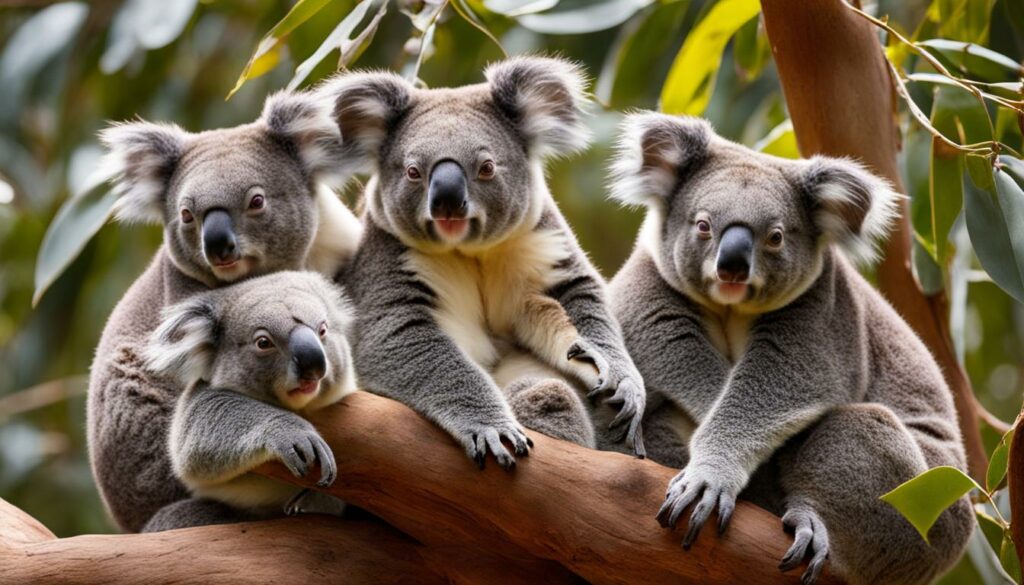
Koala Reproduction and Lifecycle
Koalas have a unique reproductive cycle that is closely tied to their arboreal lifestyle. The gestation period of a female koala lasts around 34 to 36 days, after which she gives birth to a single joey. Unlike other marsupials, the koala’s pouch is downward-facing, opening towards the hind legs. The blind and furless joey immediately crawls into its mother’s pouch, where it continues to develop and grow.
The joey stays in its mother’s pouch for approximately six months, relying on her milk for nourishment. As the joey grows, it starts to consume its mother’s pap, a protein-rich substance that aids in the development of gut microbes necessary for digesting eucalyptus leaves. At around 12 months old, the young koala becomes independent and ventures out of its mother’s territory to establish its own. This lifecycle ensures the survival and growth of the koala population.
“The gestation period of a female koala lasts around 34 to 36 days, after which she gives birth to a single joey.”
This reproductive cycle, however, poses challenges for the koala population. The low reproductive rate, combined with habitat loss and other threats, has contributed to the decline in koala numbers. Conservation efforts are essential to protect these iconic animals and their unique lifecycle. By addressing the factors that affect their reproduction and ensuring the preservation of their habitat, we can work towards a sustainable future for koalas.
The Koala Reproduction and Lifecycle at a Glance:
| Stage | Description |
|---|---|
| Gestation Period | 34-36 days |
| Birth | Single joey |
| Stay in Mother’s Pouch | Approximately 6 months |
| Consuming Mother’s Pap | From 6 to 7 months old |
| Independence | Around 12 months old |
Understanding the reproduction and lifecycle of koalas is crucial for implementing effective conservation strategies. By safeguarding their habitats, educating the public about their needs, and implementing measures to mitigate threats, we can contribute to the preservation of this iconic species for future generations.
Threats to Koala Population and Conservation Efforts
Koalas, beloved tree-dwelling marsupials native to Australia, face numerous threats to their population and habitat. The primary threat to koalas is habitat loss due to land clearing, logging, and urban development. As human populations expand and encroach upon koala habitats, the trees that provide essential food and shelter for these animals are being destroyed. This loss of habitat leads to fragmentation, isolating koala populations and making it difficult for them to find suitable resources.
Another significant threat to koalas is the risk of collisions with vehicles and attacks by domestic dogs. As koalas move through fragmented habitats, they often come into contact with roads, increasing the likelihood of fatal accidents. Additionally, encounters with dogs can result in severe injuries or death for these vulnerable animals.
Koalas also face health challenges, including diseases such as chlamydia, which can cause blindness and reproductive issues. Chlamydia spreads among koala populations, further endangering their already vulnerable numbers. Climate change exacerbates these threats by altering the availability and quality of eucalyptus trees, the main source of food for koalas.
“The conservation efforts for koalas aim to protect their population and preserve their natural habitat,” says Dr. Emily Wilson, a wildlife biologist. “Creating reserves and protected areas can provide safe havens for koalas, allowing them to thrive without human interference. Additionally, raising awareness about the importance of koala conservation can encourage communities and individuals to take action and support initiatives to protect their habitat.”
The Koala Conservation Table
| Threats to Koala Population | Conservation Efforts |
|---|---|
| Habitat loss due to land clearing, logging, and urban development | Creating reserves and protected areas |
| Collisions with vehicles and attacks by domestic dogs | Raising awareness to promote responsible pet ownership and implementing measures to reduce road accidents |
| Diseases like chlamydia | Research and treatment programs to mitigate disease transmission |
| Climate change impacts on food sources | Monitoring and addressing climate change impacts, such as reforestation and habitat restoration |
Conservation efforts for koalas require collaboration between governments, conservation organizations, and local communities. By protecting and restoring their natural habitat, addressing threats like disease and road accidents, and raising awareness, we can ensure a brighter future for these iconic Australian animals. It is imperative that we take action now to preserve the koala population for generations to come.
Conclusion
Koalas are fascinating creatures that have adapted to a life in trees through their physical features, diet, and behavior. However, they face significant challenges, including habitat loss and the impact of climate change. Conservation efforts are crucial to protect their population and habitat.
With the decline in the koala population and the destruction of their natural habitats, it is more important than ever to prioritize koala conservation. By implementing effective measures to protect their habitats from further destruction, we can help ensure the survival of these iconic Australian animals.
It is essential to raise awareness about the importance of koala conservation and get involved in initiatives that aim to protect their habitat. By supporting organizations that work towards koala conservation and advocating for their protection, we can make a positive impact and contribute to the preservation of these unique animals.
Does the Koala’s Arboreal Lifestyle Impact Their Diet Preference for Eucalyptus Trees?
Koalas’ arboreal lifestyle is closely linked to their diet preference for eucalyptus trees. They primarily feed on leaves, and different types of eucalyptus for koalas provide varying nutrients. This influences their selection of specific trees for their diet, contributing to their survival and overall health.
FAQ
What are some unique adaptations that help koalas live in trees?
Koalas have long, muscular limbs and sharp claws that help them grip tree trunks. Their fur is thicker on their rump to provide a cushion when sitting on branches.
What do koalas primarily eat?
Koalas mainly feed on eucalyptus leaves, which make up their diet and also provide them with water.
How much time do koalas spend sleeping?
Koalas spend approximately 18 to 20 hours a day sleeping to conserve energy due to their nutrient-poor diet.
What is the scientific name of koalas?
The scientific name of koalas is Phascolarctos cinereus.
Where can koalas be found?
Koalas are native to Australia and primarily inhabit the eastern and southern regions of the country. They are found in tall eucalypt forests, low woodlands, coastal areas, and even urban areas.
What is the reproductive cycle of koalas?
The gestation period of a female koala is 34-36 days, after which she gives birth to a single joey. The joey stays in the mother’s pouch for about six months, feeding on milk.
What are the threats to koalas?
Koalas face threats such as habitat loss, vehicle collisions, dog attacks, and diseases like chlamydia.

